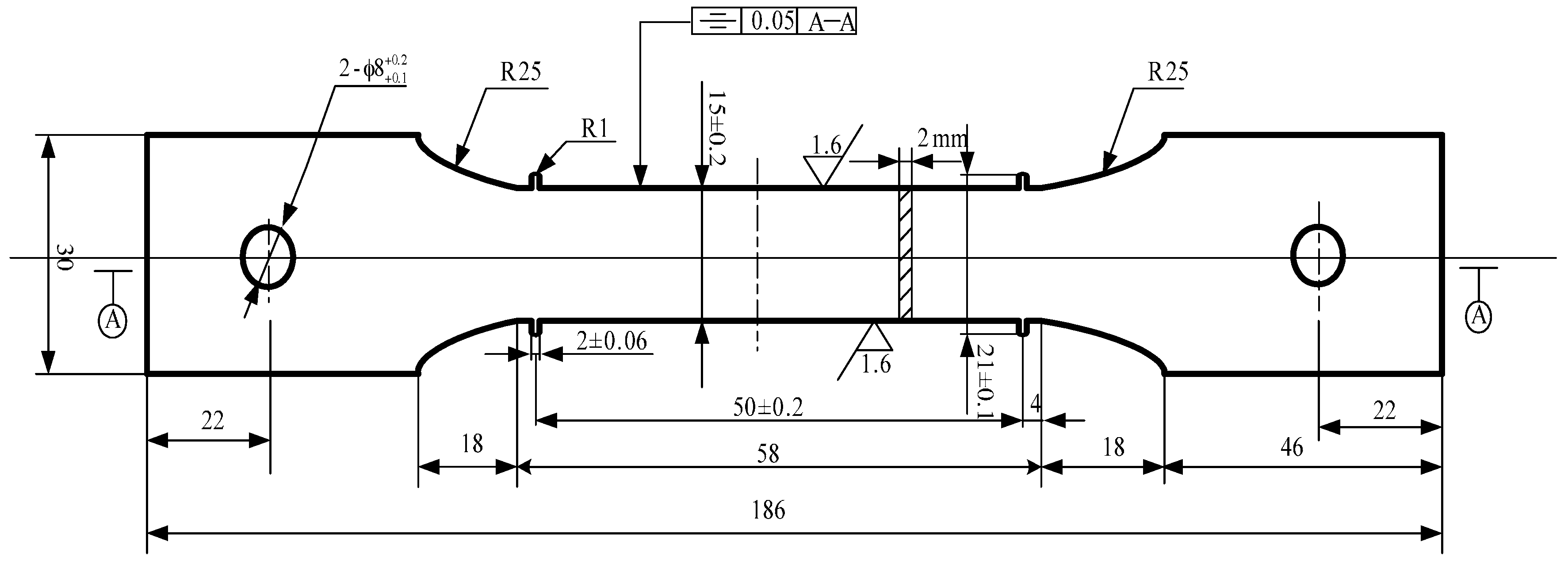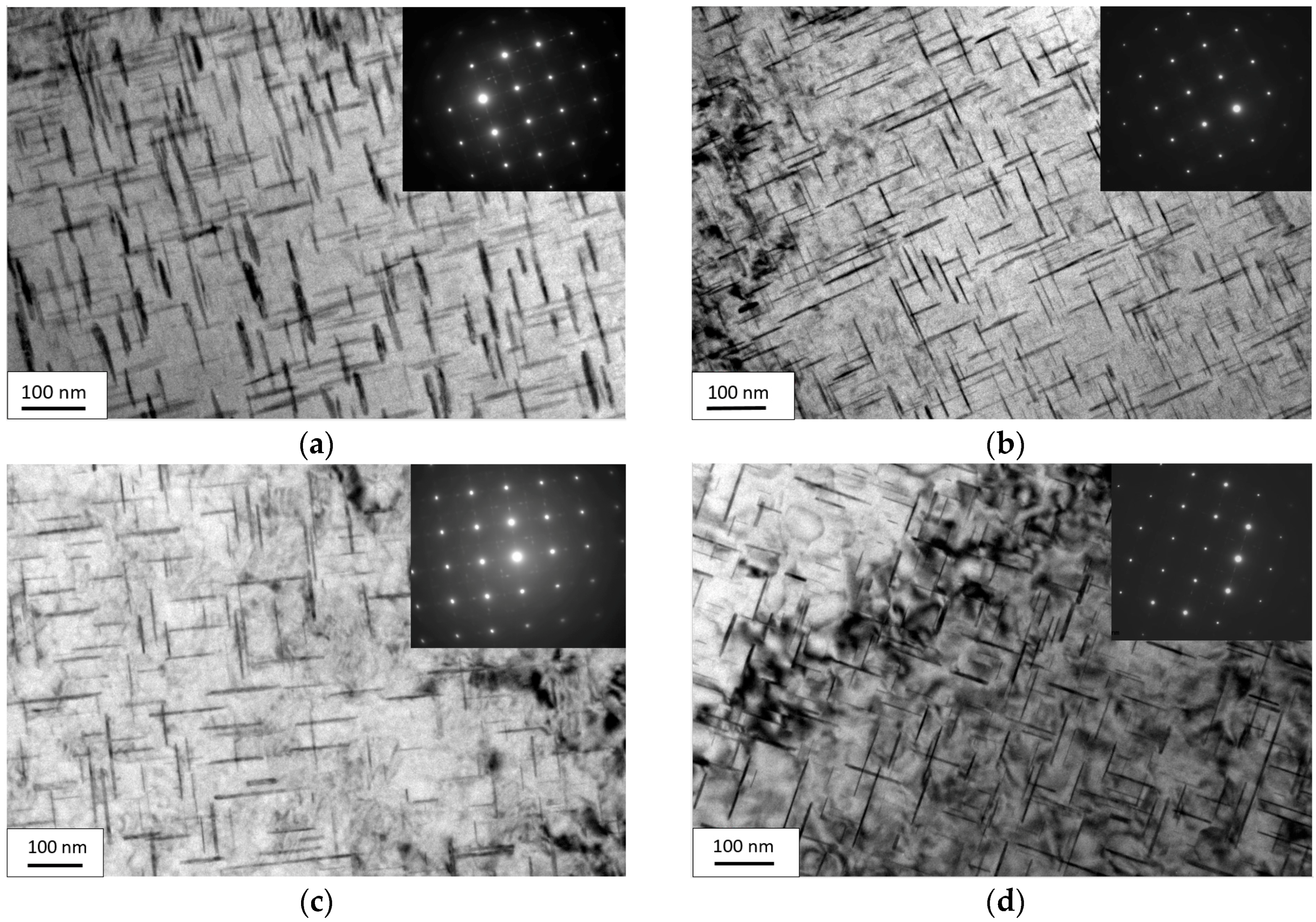Effects of Stress Relaxation Aging with Electrical Pulses on Microstructures and Properties of 2219 Aluminum Alloy
Abstract
:1. Introduction
2. Material and Methods
2.1. Material
2.2. Methods
3. Results and Analysis
3.1. Influence of the EPC on Properties of 2219 Aluminum Alloy after the Stress Relaxation Aging
3.2. Influence of Stress Relaxation Aging on the Evolution Rules for Properties of 2219 Aluminum Alloy
3.3. Influences of Electric Pulse on Evolvement Rules of Stress Relaxation Aging Properties of 2219 Aluminum Alloy
3.4. Influences of Electric Pulse on Microstructure of 2219 Aluminum Alloy
4. Conclusions
- The effects of initial stress on the mechanical properties of 2219 aluminum alloy stress relaxation aging are studied. It is found that stress relaxation aging is less affected by the initial stress, and the maximum yield strength/tensile strength difference is 8.39 MPa/7.01 MPa when the initial stress changes from 120 to 225 MPa.
- EPC promotes the aging precipitation of 2219 aluminum alloy, significantly shortening the peak aging time. In addition, within the same aging time, the mechanical properties of the specimens with EPC stress relaxation aging are higher than that with conventional stress relaxation aging.
- Compared with the conventional artificial aging, the external stress with an initial stress of 150 MPa and a tendency of constant attenuation over time delayed the aging process and slightly added to the peak strength value.
- EPC accelerated the aging precipitation behavior of the 2219 aluminum alloy, reduced the transgranular and grain-boundary energy difference, contributed to a more diffused distribution of the transgranular precipitated phase, avoided obvious PFZ and stable phase at the grain boundaries, and thus further improved the mechanical properties of the alloy.
Acknowledgments
Author Contributions
Conflicts of Interest
References
- Zeng, Y.S.; Huang, X.; Huang, S. The research situation and the developing tendency of creep age forming technology. J. Plast. Eng. 2008, 3, 1–8. [Google Scholar]
- Holman, M.C. Autoclave age forming large aluminium aircraft panels. J. Mech. Work Technol. 1989, 20, 477–488. [Google Scholar] [CrossRef]
- Yong, L.; Zhu, J. Effects of triple heat treatment on stress relaxation resistance of BT20 alloy. Mech. Mater. 2008, 40, 792–795. [Google Scholar] [CrossRef]
- Broughton, A.L. From Wellington Bombers to the A380. Int. J. Hist. Eng. Technol. 2010, 80, 55–79. [Google Scholar]
- Wang, Z.; Zhong, Y.; Cao, G.; Wang, C.; Wang, J.; Ren, W.; Lei, Z.; Ren, Z. Influence of dc electric current on the hardness of thermally aged Cu–Cr–Zr alloy. J. Alloys Compd. 2009, 479, 303–306. [Google Scholar] [CrossRef]
- Huang, J.L.; Yang, L.H.; Liu, P.; Dong, Q.M.; Yin, B. Effect of Electric Pulse Current on Microstructure and Properties of Cu-2.5Fe-0.03P-0.1Zn Alloy. J. Luoyang Inst. Technol. 2002, 4, 13–15. [Google Scholar]
- Liu, Y.; Wang, L.; Feng, F.; Zhang, B.J.; Zhao, G.P. Effects of electropulsing treatment on coarsening behavior of γ’ phase in a nikel base superalloy. J. Mater. Metall. 2011, 4, 288–291. [Google Scholar]
- Wang, Y.C. Effects of Pulse Current Treatment on the Precipitation Behavior of Carbides for GH3044. Master’s Thesis, Northeastern University, Shenyang, China, 2009. [Google Scholar]
- Jia, W.; Deng, J.N.; Zeng, M.G. Effect of Electropulsing on the Phase Transformation Dynamics of Al-matrix Nanocrystalline Alloy. Trans. Metal Heat Treat. 2004, 25, 5–7. [Google Scholar]
- Conrad, H. Effects of electric current on solid state phase transformations in metals. Mater. Sci. Eng. A 2000, 287, 227–237. [Google Scholar] [CrossRef]
- To, S.; Zhu, Y.H.; Lee, W.B.; Tang, G.Y.; Liu, X.M.; Jiang, Y.B. Effects of dynamic electropulsing on phase transformation of a Zn-Al based alloy. Mater. Trans. 2009, 50, 1105–1112. [Google Scholar] [CrossRef]
- Witt, C.; Volkert, C.A.; Arzt, E. Electromigration-induced Cu motion and precipitation in bamboo Al–Cu interconnects. Acta Mater. 2003, 51, 49–60. [Google Scholar] [CrossRef]
- Kaibyshev, R.; Sitdikov, O.; Mazurina, I.; Lesuer, D.R. Deformation behavior of a 2219 Al alloy. Mater. Sci. Eng. A 2002, 334, 104–113. [Google Scholar] [CrossRef]
- Liu, C.F. Electron Beam Welding of Al-Alloy 2219 Family for Launch Vehicle Tanks. Aerosp. Manufac-Turing Technol. 2002, 8, 3–9. [Google Scholar]
- China Standards Publication. Metallic Materials.Uniaxial Creep Testing Method in Tension; GB/T 2039-2012; China Standards Press: Beijing, China, 2012. [Google Scholar]
- Chen, Y.Q. Effect of Creep Aging on Microstructure and Properties of 7050 Aluminum Alloy. Master’s Thesis, Central South University, Changsha, China, 2011. [Google Scholar]
- Li, J.; Zheng, Z.; Li, S.; Yin, S.; Liu, Z. Kinetics Study on Stress Aging of Al-Cu Alloy. Chin. J. Rare Metals 2005, 29, 539–544. [Google Scholar]
- Chen, D.Q.; Zheng, Z.Q.; Li, S.C.; Chen, Z.G.; Liu, Z.Y. Effect of External Stress on the Growth of Precipitates in Al-Cu and Al-Cu-Mg-Ag Alloys. Acta Metall. Sin. 2004, 8, 799–804. [Google Scholar]
- Wang, H.; Wang, D.; Cai, J.; Wang, B. Effect of stress aging on mechanical properties and microstructures of 2E12 aluminum alloy. Chin. J. Nonferrous Metals 2011, 12, 3019–3025. [Google Scholar]



| Element | Cu | Mg | Mn | Fe | Si | Zn | Zr | Al |
|---|---|---|---|---|---|---|---|---|
| Content (wt %) | 5.8–6.8 | 0.02 | 0.2–0.4 | 0.3 | 0.2 | 0.1 | 0.1–0.25 | Bal. |
| Initial Stress (MPa) | σs/MPa | σb/MPa | δ/% | |||
|---|---|---|---|---|---|---|
| Convention | EPC | Convention | EPC | Convention | EPC | |
| 120 | 376.09 | 385.12 | 460.17 | 465.97 | 10.70 | 9.94 |
| 150 | 372.80 | 388.38 | 454.29 | 476.85 | 9.02 | 9.41 |
| 180 | 372.62 | 387.95 | 456.97 | 473.41 | 8.78 | 8.90 |
| 195 | 370.23 | 386.35 | 459.96 | 474.77 | 9.07 | 10.09 |
| 210 | 377.63 | 386.96 | 461.30 | 474.92 | 8.90 | 10.21 |
| 225 | 378.62 | 388.36 | 458.17 | 476.85 | 8.57 | 8.47 |
| Aging Time (h) | σs/MPa | σb/MPa | δ/% | |||
|---|---|---|---|---|---|---|
| 0 MPa | 150 MPa | 0 MPa | 150 MPa | 0 MPa | 150 MPa | |
| 0 | 302.66 | 302.66 | 364.85 | 364.85 | 17.97 | 17.97 |
| 1 | 336.78 | 332.58 | 423.93 | 425.70 | 18.45 | 16.44 |
| 5 | 373.60 | 361.25 | 451.54 | 442.88 | 44.15 | 10.02 |
| 9 | 383.11 | 366.21 | 457.25 | 449.84 | 8.46 | 9.76 |
| 11 | 381.56 | 372.8 | 459.07 | 454.29 | 10.62 | 9.02 |
| 13 | 378.90 | 379.27 | 452.58 | 459.92 | 10.17 | 9.60 |
| 15 | - | 388.15 | - | 472.15 | - | 10.98 |
| 18 | - | 374.47 | - | 453.44 | - | 8.14 |
| Aging Time (h) | σs/MPa | σb/MPa | δ/% | |||
|---|---|---|---|---|---|---|
| Convention | EPC | Convention | EPC | Convention | EPC | |
| 1 | 332.58 | 339.58 | 425.70 | 426.24 | 16.44 | 14.88 |
| 5 | 361.25 | 375.20 | 442.88 | 458.26 | 10.02 | 13.02 |
| 9 | 366.21 | 378.31 | 449.84 | 462.76 | 9.76 | 11.68 |
| 11 | 372.80 | 388.38 | 454.29 | 476.85 | 9.02 | 9.41 |
| 13 | 379.27 | 386.70 | 459.92 | 472.83 | 9.60 | 8.66 |
| 15 | 388.15 | - | 472.15 | - | 10.98 | - |
| 18 | 374.47 | - | 453.44 | - | 8.14 | - |
© 2016 by the authors; licensee MDPI, Basel, Switzerland. This article is an open access article distributed under the terms and conditions of the Creative Commons Attribution (CC-BY) license (http://creativecommons.org/licenses/by/4.0/).
Share and Cite
Tan, J.; Zhan, L.; Zhang, J.; Yang, Z.; Ma, Z. Effects of Stress Relaxation Aging with Electrical Pulses on Microstructures and Properties of 2219 Aluminum Alloy. Materials 2016, 9, 538. https://doi.org/10.3390/ma9070538
Tan J, Zhan L, Zhang J, Yang Z, Ma Z. Effects of Stress Relaxation Aging with Electrical Pulses on Microstructures and Properties of 2219 Aluminum Alloy. Materials. 2016; 9(7):538. https://doi.org/10.3390/ma9070538
Chicago/Turabian StyleTan, Jingsheng, Lihua Zhan, Jiao Zhang, Zhan Yang, and Ziyao Ma. 2016. "Effects of Stress Relaxation Aging with Electrical Pulses on Microstructures and Properties of 2219 Aluminum Alloy" Materials 9, no. 7: 538. https://doi.org/10.3390/ma9070538
APA StyleTan, J., Zhan, L., Zhang, J., Yang, Z., & Ma, Z. (2016). Effects of Stress Relaxation Aging with Electrical Pulses on Microstructures and Properties of 2219 Aluminum Alloy. Materials, 9(7), 538. https://doi.org/10.3390/ma9070538







